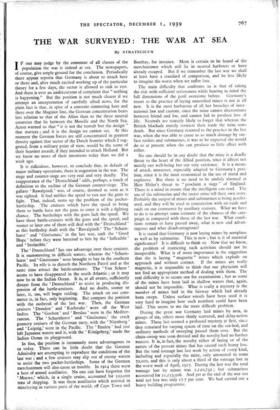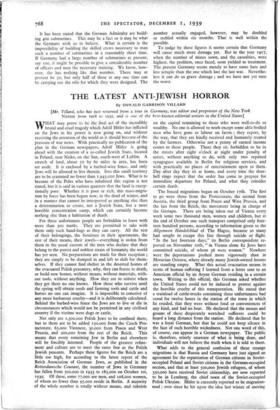THE WAR SURVEYED : THE WAR AT SEA
By STRATEGICUS
IF one may judge by the comment of all classes of the 1 population the war is indeed at sea. The newspapers, of course, give ample ground for the conclusion. Periodically there appear reports that Germany is about to attack here or there and, after much excited working up of the particular theory for a few days, the sector is allowed to sink to rest. And there is ever an undercurrent of complaint that " nothing is happening." But the position is not much clearer if we attempt an interpretation of carefully sifted news, for the plain fact is that, in spite of a constant simmering here and there over the Maginot line, the German concentration bears less relation to that of the Allies than to the three neutral countries that lie between the Moselle and the North Sea.
Acton warned us that " it is not the tumult but the design " that matters ; 'and it is the design we cannot see. At this moment the German forces are still concentrated in greatest density against that sector of the Dutch frontier which I sug- gested, from a military point of view, would be the scene of their heaviest assault, if they intended to attack Holland. But we know no more of their intentions today than we did a week ago.
It is ridiculous, however, to conclude that, in default of major military operations, there is stagnation in the war. The siege and counter-siege are very real and very deadly. The reappearance of the Deutschland' adds, perhaps, a touch of definition to the outline of the German counter-siege. The gallant Rawalpindi ' was, of course, doomed as soon as it was sighted. It had neither the speed to run nor the guns to fight. That, indeed, sums up the problem of the pocket- battleship. The cruisers which have the speed to bring them to battle have not the guns to enter it with a fighting chance. The battleships with the guns lack the speed. We have three battle-cruisers with the guns and the speed, and sooner or later one of them will deal with the Deutschland ' as this battleship dealt with the Rawalpindi.' The ' Scharn- horst ' and Gneisenau,' in the last war, sank the Good Hope' before they were battered to bits by the ' Inflexible ' and Invincible.'
The Deutschland ' has one advantage over these cruisers. It is manoeuvring in difficult waters, whereas the Scharn- horst ' and Gneisenau ' were brought to bay in the southern Pacific. Its role is to disturb the Northern Patrol and at the same time attract the battle-cruisers. The Won Scheer' seems to have disappeared in the south Atlantic ; or it may now be in the Indian Ocean. It is, at all events, sufficiently distant from the Deutschland' to assist in producing dis- persion of the battle-cruisers. And no doubt, sooner or later, it, too, will begin raiding. The attack on our com- merce is, in fact, only beginning. But compare the position with the outbreak of the last war. Then, the German cruisers Dresden' and Karlsruhe ' were off the West Indies. The Goeben ' and Breslau' were in the Mediter- ranean. The Scharnhorst ' and Gneisenau,' the crack gunnery cruisers of the German navy, with the Nurnberg ' and Leipzig,' were in the Pacific. The Emden ' had just left Japanese waters and it, with the Konigsberg,' made the Indian Ocean its playground.
In fine, the position is immensely more advantageous to us today. There can be little doubt that the German Admiralty are attempting to reproduce the conditions of the last war ; and a few cruisers may slip out of enemy waters to assist the two pocket-battleships. Some of the German merchantmen will also cause us trouble. In 1914 there were a host of armed auxiliaries. No one can have forgotten the Moewe,' which, in a single cruise, accounted for 122,000 tons of shipping. It was these auxiliaries which assisted in minelaying in various parts of the world, off Cape Town and Bombay, for instance. More is certain to be heard of the merchantmen which still lie in neutral harbours or have already escaped. But if we remember the last war we shall at least have a standard of comparison, and be less likely to imagine the worst when we suffer loss.
The main difficulty that confronts us is that of taking the risk with sufficient seriousness while bearing in mind the full dimensions of the peril overcome before. Germany's resort to the practice of laying unnotified mines is not at all new. It is the most barbarous of all her breaches of inter- national law and custom, since the mine cannot discriminate between friend and foe, and cannot fail to produce loss of life. Neutrals are scarcely likely to forget that whereas the British blockade merely restricts their trade the mine sows death. But since Germany resorted to the practice in the last war, when she was able to cause us so much damage by sur- face raiders and submarines, it was to be expected she would do so at present when she can produce so little effect with either.
No one should be in any doubt that the mine is a deadly threat to the heart of the Allied position, since it affects not merely our well-being but our very existence. It is a means of attack, moreover, especially adapted to Germany's posi- tion, since it is the most economical in the use of metal and explosive. But there is no need to be unduly alarmed at Herr Hitler's threat to " proclaim a siege " of England. There is a mind in events that the intelligent can read. The use of the submarine and the secret mine tell their own story. Probably the output of mines and submarines is being acceler- ated, and they will be used in conjunction with air-raids and raids on our commerce by auxiliary cruisers. What we have to do is to attempt some estimate of the chances of the cam- paign as compared with those of the last war. What condi- tions remain or have passed away, what is new and advan- tageous and what disadvantageous?
It is stated that Germany is now laying mines by aeroplane as well as by submarine. This is new ; but is it of essential significance? It is difficult to think so. Now that we know, the problem of restricting such activities should not be insuperable. What is of more importance is the suggestion that she is laying " magnetic " mines which explode on approach and without contact. If the mines are really magnetic, it is impossible to think that our physicists will not find an appropriate method of dealing with them. The real difficulty is to secure one for examination ; but as some of the mines have been laid in shallow waters that, again, should not be impossible. What is really a mystery is the number of mines laid in the fairway which had already been swept. Unless surface vessels have been used it is very hard to imagine how such numbers could have been laid. This seems to me the more difficult problem.
During the great war Germany laid mines by area, in groups of six, others more thinly scattered, and delay-action mines. These last seemed a profound mystery at first, since they remained for varying spaces of time on the sea-bed, and ordinary methods of sweeping passed them over. But the chain-sweep was soon devised and the novelty had no further success. It is, in fact, the novelty either of laying or of the nature of the present mines that has caused such heavy loss. But the total tonnage lost fast week by action of every kind, including and especially the mine, only amounted to some 72,000, and this is only about a third of the tonnage lost in the worst week of April, 1917. During the last war the total tonnage lost by mines was 1,120,732 ; but submarines accounted for 11,153,506. And yet at the end of the war our total net loss was only 17.7 per cent. We had carried out a heavy building programme. It has been stated that the German Admiralty are build- ing 400 submarines. This may be a fact or it may be what the Germans wish us to believe. What is certain is the impossibility of building the skilled crews necessary to man such a number of submarines in a reasonably short time. If Germany had a large number of submarines at present, say too, it might be possible to give a considerable number of officers and men the necessary training. We know, how- ever, she has nothing like that number. There may at present be 50, but only half of these at any one time can be carrying out the role for which they were designed. The number actually engaged, however, may be doubled or trebled within six months. That is well within the possible.
To judge by these figures it seems certain that Germany will cause much more damage yet. But in the year 1917, when the number of mines sown, and the casualties, were highest, the problem, once faced, soon yielded to treatment. The present Germany seems merely to have more hate and less scruple than the one which lost the last war. Neverthe- less it can do us grave damage ; and we have not yet seen the worst.













































 Previous page
Previous page